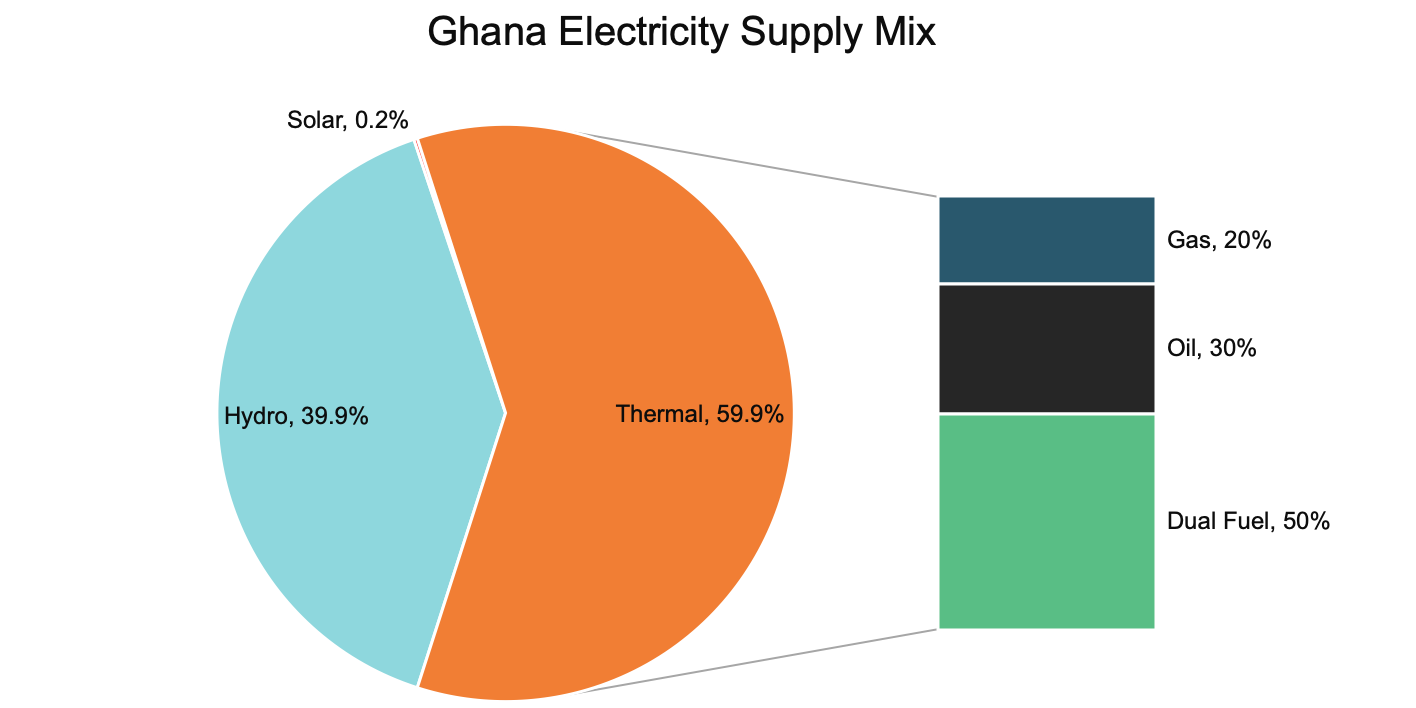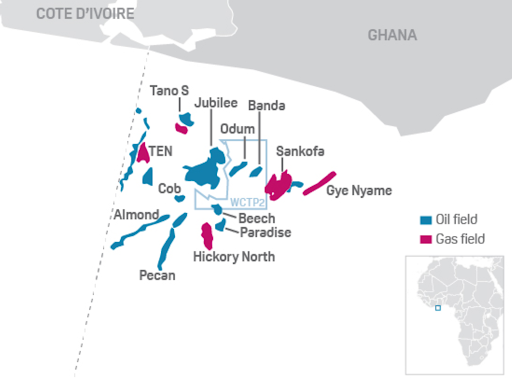Ghana is fast approaching 100% electrification, but continues to battle with irregular electrical power supply. In 2014, Ghanaians experienced severe power outages — known as “dumsor” — with the productivity losses estimated at 2 percent of GDP.1,2 Reliability has since improved but hydropower remains vulnerable to erratic rainfall (for generation via the Bui, Kpong and Akosombo dams) and thermal power is subject to volatile oil prices and inconsistent gas supply from the West African Gas Pipeline (WAGP).3 Domestic natural gas production could provide reliable and low cost electricity for Ghana, if it can be developed. A joint project, Sankofa gas project, aimed at developing natural gas off the coast of Ghana promises to transform the country’s energy mix.
Ghana’s existing thermal generation can be switched or retrofitted for gas
Ghana currently has ten thermal power plants that generate ~60% of its power: five run on dual fuel (oil/gas), two on natural gas, and three on crude oil.4 The development of a secure and stable domestic gas supply from domestic sources represents an opportunity to switch fuel supply from oil-based power generation to a cleaner and cheaper natural gas-based power generation to power all ten plants (see current energy mix in figure 1). Retrofitting only the oil-based power generation facilities requires capital investment, while the dual-fuel power plants may switch to natural gas relatively smoothly with little to no cost. Switching to fully natural gas-based generation supplied by domestic sources can stabilize the energy supply and also transform the energy landscape for Ghana: a key goal of the Government of Ghana (GoG) and the Volta River Authority (main power generation authority).
FIGURE 1

Source: Ghana Energy Commission4
Sankofa Gas Project: a potential breakthrough
The Sankofa Gas field, a part of the Offshore Cape Three Points Project (see Figure 3), was discovered in the Western Region of Ghana in 2009. It is the largest potential source of domestic gas in Ghana and is expected to produce up to one trillion cubic feet of non-associated gas when fully developed.3 The project is being developed by a partnership of the parastatal, Ghana National Petroleum Corporation (GNPC), and two private energy companies, Eni of Italy and Vitol in the Netherlands. The project is estimated to require US$ 7.7 billion investment and will be developed in four phases:
FIGURE 2: Sankofa Gas Project Development Phases

FIGURE 3: Significant Offshore Oil Finds in Ghana

Source: S&P Global5
The potential economic benefits are vast
Natural gas from the Sankofa project alone could replace 60 percent of the electricity generation from other thermal sources, as shown in Figure 1. Together, domestic gas supply and imports from WAGP will be a cheaper source of fuel for electricity generation. The price of gas from WAGP is approximately $8 per mmbtu.6 As long as the price of gas from WAGP and Sankofa remains competitive, relative to crude oil, gas becomes a better substitute for power production in Ghana.
$1.2 Billion
Ghana will save approximately $1.2 billion on power generation by switching from crude oil to natural gas.
Even if the price of gas from the Sankofa project is higher than that from WAGP or crude oil, there are still potential economic benefits to developing the projects:
- Billions in direct revenue. The GoG, through GNPC, is expected to receive US$2.3 billion in direct revenue.7
- Job creation. Just as the exploration of oil has created jobs, a thriving gas sector, even if only for export or industrial uses, has the potential to create thousands of jobs.
- Expertise development. Developing homegrown expertise in a high-demand sector will provide long-term benefits. Already, Ghana’s large hydropower expertise has been deployed in the region, and the development of gas expertise from Sankofa could become an asset deployed in other producing countries in Africa.8
Despite the benefits of the project, there are a number of threats to its viability – 1) although the political atmosphere in Ghana has been stable, any disturbances could destabilize the timeline of the project implementation, 2) Ghana’s continuous growing budget deficits would make it difficult for the government to raise the needed financial investments on its part, and last but not least 3) continuous provision of physical security for firms and their employees working on the project is needed to ensure smooth project implementation.
Conclusion: Developing the Sankofa natural gas project and switching electricity production from crude oil to natural gas, will not only ensure reliable electricity to power Ghana and the sub-region, but also a reduction in greenhouse emissions from crude oil based thermal plants. Reliable power supply would reduce the risk of another episode of dumsor and increase domestic economic activity. Ghana, through this project, could become a major player in the West African geopolitical space of natural gas producers.
Endnotes
- E. Nyarko Kumi, “The electricity Situation in Ghana. challenges and opportunities.” Center for Global Development, Sep-2017.
- C. Ackah, “Workshop on Electricity Insecurity and Its Impact on the Economy of Ghana,” University of Ghana, 14-May-2015.
- R. Schlotterer and P. Gupta, “Financial Solutions Brief Ghana Sankofa Gas Project.” World Bank Group, Jan-2018.
- A. Ofosu-Ahenkorah, “ENERGY COMMISSION_2018 Energy Outlook_2018.pdf.” Ghana Energy Commission, Apr-2018.
- S&P Global, “Springfield flags ‘significant’ oil find offshore Ghana,” 2019
- M. Fulwood and T. Bros, “Future-prospects-for-LNG-demand-in-Ghana-Insight-26.pdf.” The Oxford Insiitute For Energy Studies, Jan-2018.
- M. Diop, “Document of The World bank.” The World Bank, 07-Jul-2015.
- L. Quartey, “VRA commended for restoring electricity to Liberia,” Ghana News Agency, 13-Mar-2008.
